-
+86 15030157877
-
sales@galvanizedmetalmesh.com
Nov . 19, 2024 08:56 Back to list
Durable Stainless Steel Welded Wire for Versatile Applications and Reliable Performance
The Significance of Stainless Steel Welded Wire An Overview
Stainless steel welded wire is a versatile and durable material widely used in various industries due to its strength, corrosion resistance, and longevity. Made from stainless steel, which contains iron, chromium, and other alloying elements, this type of wire offers superior performance compared to regular steel alternatives. Its unique properties make it an essential choice for applications ranging from construction to agriculture.
One of the most significant advantages of stainless steel welded wire is its resistance to corrosion. Stainless steel's chromium content forms a passive layer of chromium oxide on the surface, protecting it from rust and corrosion in a variety of environments. This quality is particularly valuable in outdoor applications or regions with high humidity, where traditional steel may deteriorate quickly. Industries such as construction, marine, and agriculture benefit immensely from the longevity that stainless steel welded wire provides.
The manufacturing process of stainless steel welded wire involves welding wires together at predetermined intervals to form a grid. This process not only increases the strength of the product but also allows for a variety of mesh sizes and configurations to be produced. The welded wire can be utilized for fencing, reinforcement in concrete, or even in architectural applications where aesthetic and structural performance is required. The flexibility in customization makes it suitable for diverse applications, particularly in residential and industrial construction.
stainless steel welded wire

In agriculture, stainless steel welded wire serves many purposes, often found in the construction of enclosures for livestock and the protection of crops. Farmers and ranchers choose this material for its durability and resistance to harsh environmental conditions. Unlike other types of wire, stainless steel will not easily bend, break, or rust, ensuring the safety and security of animals and crops over long periods. This longevity translates to cost savings, as it reduces the need for frequent replacements and repairs.
Another important application of stainless steel welded wire is in the food processing industry. Given its non-reactive properties, stainless steel is an ideal choice for equipment and structures that come into contact with food. It ensures that food products remain uncontaminated and safe for consumption. This characteristic also makes it suitable for use in sanitary environments, such as hospitals and laboratories, where hygiene is paramount.
Furthermore, the aesthetic qualities of stainless steel welded wire cannot be overlooked. Its sleek, modern appearance can enhance the visual appeal of structures, making it a popular choice for decorative fencing, railings, and architectural accents. Designers and architects appreciate the combination of functionality and aesthetics that stainless steel welded wire offers.
In conclusion, stainless steel welded wire is an essential material that crosses multiple industries, providing a reliable solution for various applications. Its durability, corrosion resistance, and aesthetic appeal make it a top choice for builders, engineers, and farmers alike. Whether in construction, agriculture, or food processing, the benefits of stainless steel welded wire resonate through its long-lasting performance and versatility. As industries continue to seek materials that can withstand environmental challenges while providing safety and functionality, stainless steel welded wire will undoubtedly remain a staple choice in manufacturing and construction applications. Its remarkable properties ensure that it is well-suited for the demands of modern society, contributing to sustainable practices and longer life cycles for products built with its use.
-
Stainless Steel Wire Mesh: Durable & Corrosion-Resistant Rolls
NewsAug.26,2025
-
Durable Fences: Garden, Pool, Metal & Security Solutions
NewsAug.25,2025
-
Perforated Metal Mesh Sheets: Custom & Wholesale Solutions
NewsAug.24,2025
-
Durable Metal Mesh Fabric For Glass Laminated | Strength & Style
NewsAug.23,2025
-
Hexagonal Wire Mesh: Durable Galvanized & PVC Coated Rolls
NewsAug.22,2025
-
Durable Hexagonal Gabions for Erosion Control & Retaining Walls
NewsAug.21,2025



